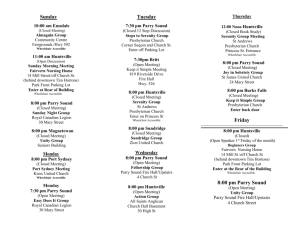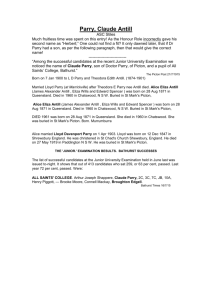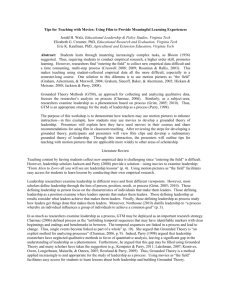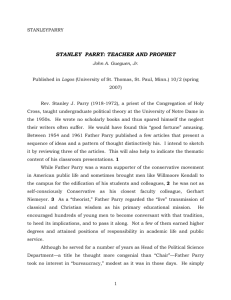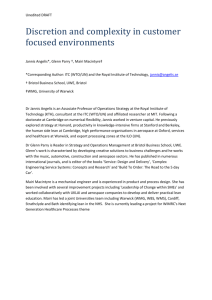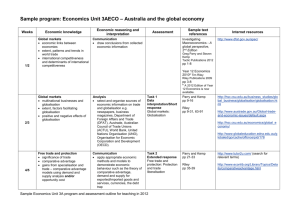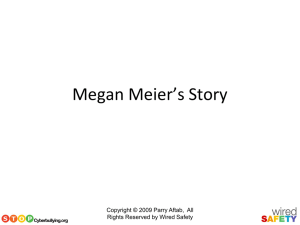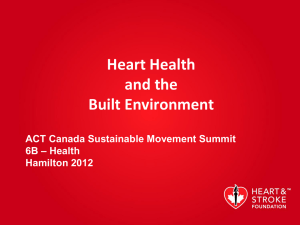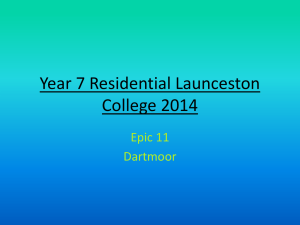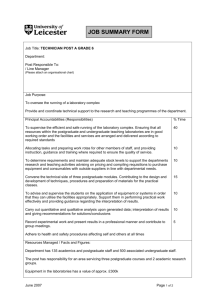Charman, Parry, Blake SHET project FINAL report form
advertisement
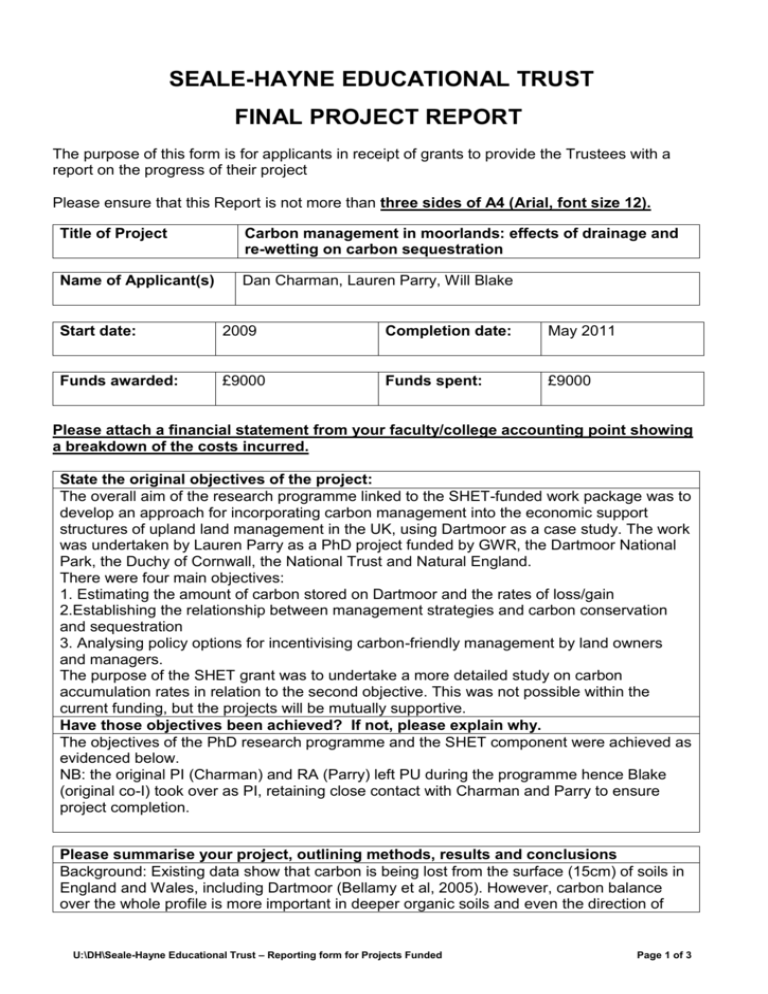
SEALE-HAYNE EDUCATIONAL TRUST FINAL PROJECT REPORT The purpose of this form is for applicants in receipt of grants to provide the Trustees with a report on the progress of their project Please ensure that this Report is not more than three sides of A4 (Arial, font size 12). Title of Project Carbon management in moorlands: effects of drainage and re-wetting on carbon sequestration Name of Applicant(s) Dan Charman, Lauren Parry, Will Blake Start date: 2009 Completion date: May 2011 Funds awarded: £9000 Funds spent: £9000 Please attach a financial statement from your faculty/college accounting point showing a breakdown of the costs incurred. State the original objectives of the project: The overall aim of the research programme linked to the SHET-funded work package was to develop an approach for incorporating carbon management into the economic support structures of upland land management in the UK, using Dartmoor as a case study. The work was undertaken by Lauren Parry as a PhD project funded by GWR, the Dartmoor National Park, the Duchy of Cornwall, the National Trust and Natural England. There were four main objectives: 1. Estimating the amount of carbon stored on Dartmoor and the rates of loss/gain 2.Establishing the relationship between management strategies and carbon conservation and sequestration 3. Analysing policy options for incentivising carbon-friendly management by land owners and managers. The purpose of the SHET grant was to undertake a more detailed study on carbon accumulation rates in relation to the second objective. This was not possible within the current funding, but the projects will be mutually supportive. Have those objectives been achieved? If not, please explain why. The objectives of the PhD research programme and the SHET component were achieved as evidenced below. NB: the original PI (Charman) and RA (Parry) left PU during the programme hence Blake (original co-I) took over as PI, retaining close contact with Charman and Parry to ensure project completion. Please summarise your project, outlining methods, results and conclusions Background: Existing data show that carbon is being lost from the surface (15cm) of soils in England and Wales, including Dartmoor (Bellamy et al, 2005). However, carbon balance over the whole profile is more important in deeper organic soils and even the direction of U:\DH\Seale-Hayne Educational Trust – Reporting form for Projects Funded Page 1 of 3 change is unknown. The nature and pathways of possible loss include erosion of particulates, enhanced soil respiration and loss in runoff and carbon dioxide emissions (e.g. Worrall et al. 2004). The focus of this project is on rates of total carbon loss and accumulation (carbon balance) in relation to long-term management. Methods: 1. A series of plots were identified on northern Dartmoor, which had been subject to three contrasting management regimes; 1) a drained area with only light burning, 2) an undrained area also subject to only light burning, 3) a heavily burned area. All these locations had otherwise similar characteristics in terms of soil type, elevation, slope and vegetation. 2. Three peat profiles in each plot were sampled for carbon content and bulk density. Counts of spheroidal carbonaceous particles (a marker for the large rise in combustion of oil and coal in the 1950s) have been undertaken to provide independent support to geochronology from fallout radionuclides 3. Samples for each profile were analysed for fallout radio-isotopes Lead-210, Caesium137 and Americium-241. It was proposed that the continuous chronology that these provide for all depths of peat accumulated over the last c. 100 years would permit us to infer accumulation rates and the impact of the different management regimes. Variability between the profiles of cores in the same unit was linked to spatial location of cores with respect to erosion scars and hence drainage with important messages for future sampling strategies (many studies to date have relied on individual cores). 4. Best estimates of changes in carbon accumulation rates under different management scenarios were achieved by combining the evidence from SCPs and fallout radionuclides to use alongside bulk density and soil carbon data. Key findings: The key research outcomes are in four main areas: 1. It provided a new basis for estimating the carbon store in upland peatlands that is much more accurate than previous methodologies. The approach is now being adopted nationally and Parry is advising on this process. 2. It demonstrated that carbon sequestration rates are affected in different ways by different management strategies. This finding will serve to inform future management strategy for carbon storage on upland peatlands. 3. It tested different methods for dating recent peat and carbon accumulation. This has important implications for carbon accumulation studies but also much wider implications for a range of earth and environmental sciences that make use of these techniques. 4. It provided a basis for future projections of carbon storage using scenario planning. This approach could be developed to address long-term planning of upland management for carbon storage. What specific outcomes (tangible or intangible) have arisen from this research (including publication, events, media interest and other forms of dissemination)? Academic papers: Parry, L. E., Charman, D. J., Noades, J. P. W. Methods for modelling peat depth in blanket peatlands. Soil Use and Management, accepted subject to revision. Billett M.F., Charman D.J., Clark J.M., Evans C.D., Evans M.G., Ostle N.J., Worrall F., Burden A., Dinsmore K.J., Jones T., McNamara N.P., Parry L., Rowson J.G., Rose, R. (2010) Carbon balance of UK peatlands: current state of knowledge and future research U:\DH\Seale-Hayne Educational Trust – Reporting form for Projects Funded Page 2 of 3 challenges. Climate Research 45, 13-29. Conference presentations: Invited Presentations Parry, L.E. (2010). 'Sustainable Carbon Management of British Blanket Peatlands: a case Study on Dartmoor'. Great Western Research Seminar Series Parry, L.E. (2010). 'Sustainable Carbon Management of British Blanket Peatlands: a case Study on Dartmoor'. The Dartmoor Society. Annual Research Lecture Parry, L. E. (2009). The sustainable carbon management of moorlands. South West Soils Group Meeting. North Wyke Research, Devon Parry, L. E. (2008). The sustainable carbon management of Dartmoor National Park’s peatland environment. Dartmoor Common Owner’s AGM, Two Bridges, Dartmoor Parry, L. E. (2007). Policy and Practice for the Sustainable Carbon Management of Moorland. Dartmoor Biodiversity Research Group Meeting, DMNP Bovey Tracy, Devon Conference Presentations Parry, L. E. (2010). The sustainable carbon management of moorlands. School of Geography Physical Geography Postgraduate Conference, Exeter. 45 minute oral presentation. Parry, L. E. and Charman, D. J. (2010). Methods for modelling soil organic carbon distribution at a landscape scale: A case study on Dartmoor, Southwest England. School of Geography Physical Geography Postgraduate Conference, Exeter. Poster Presentation. Parry, L. E. (2010). The sustainable carbon management of moorlands: a case study on Dartmoor National Park. Climate Change and Sustainable Futures Postgraduate Conference, Exeter. Oral Presentation. Parry, L. E. and Charman, D. J. (2010). Methods for modelling soil organic carbon distribution at a landscape scale: A case study on Dartmoor, Southwest England. Climate Change and Sustainable Futures Postgraduate Conference, Exeter. Poster Presentation. Parry, L. E and Charman, D. J. (2009). Methods for modelling soil organic carbon distribution at a landscape scale: A case study on Dartmoor, Southwest England. Carbon in Peatlands: 2nd International Symposium. Prague, Czech Republic. Poster Presentation. Parry, L. E. (2009). Methods for sustainably managing carbon in moorlands. Plymouth Postgraduate Symposium, Plymouth. Oral Presentation. Parry, L. E. (2008). Policy and Practice for the Sustainable Carbon Management of Moorlands. Great Western Research Symposium, Bristol. Poster Presentation. Parry, L. E. (2008). Policy and Practice for the Sustainable Carbon Management of Moorlands. Plymouth Postgraduate Symposium, Plymouth. Poster Presentation. Parry, L.E. (2008). Policy and Practice for the Sustainable Carbon Management of Moorlands. Great Western Research Meeting, Exeter. Oral Presentation. Career development: Lauren Parry gained employment 3 months after her PhD research in a directly relevant position working as the Knowledge Transfer Partnership Environmental Engineer with Dinsdale Moorland Management/University of Leeds. U:\DH\Seale-Hayne Educational Trust – Reporting form for Projects Funded Page 3 of 3
